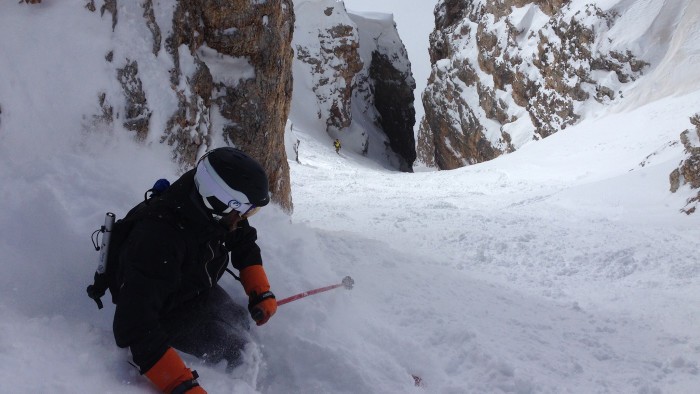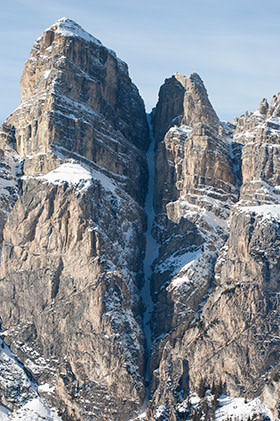Couloirs and Michelin stars in the Dolomites

Simply sign up to the Life & Arts myFT Digest -- delivered directly to your inbox.
In the dark cellar beneath the hotel Ciasa Salares, the owner Stefan Wieser was uncorking bottles with abandon. “So, I thought you might like to take a little panorama of Italian wines,” he said, gesturing at the bottles on the wooden shelves all around us and at the table full of wine glasses, sparkling in the candlelight. There were some 16,000 bottles, perhaps 50 glasses, four of us; a long night of gluttony stretched ahead.
The Ciasa Salares sits on a flank of the 3,064m-high Piz dles Cunturines, but this is no mountaineers’ refuge. Though it has just 50 bedrooms, there are three restaurants, including the Michelin-starred La Siriola and the wine cellar beneath it. Wieser proffered local Gewürztraminer, Pinot Grigio and Lagrein, biodynamic Ribolla and Sauvignon Blanc, possibly more (my notes become hazy). His son, Clemence, listened intently, fetching the bottles his father requested. When we moved upstairs, a troupe of waiters brought food as sophisticated as at any big city restaurant — wild duck with apricot mousse, Alpine char sashimi with trout caviar, pork and langoustine with a waft of “pig smoke” from a Kilner jar.
The strange thing is that La Siriola isn’t the only temple of gastronomy to have ended up in the upland farming communities hereabouts. Stefan’s cousin, Hugo Pizzinini, runs the hotel Rosa Alpina in San Cassiano, a village of 850 souls just down the road; its restaurant has two stars. A bit further on is Corvara, where we were staying for the week and where the hotel La Perla also boasts a star. In fact, the Südtirol, this mountainous area pushed up against the Austrian and Swiss borders, has more Michelin stars than any other Italian province.
Six courses done with, we were led to the chocolate room, a small wood-panelled chamber filled with every type of truffle, blocks of high-cocoa content chocolate from around the world, and chocolate-covered orange peel, ginger, strawberries, banana . . . In the corner a chef was on standby beside a bubbling brown fountain, in case anything else needed coating.
It was close to midnight when we finally emerged and crunched through deep snow to the car. On the drive back to Corvara, we looked up through windows fogged with alcoholic breath at the Sassongher, the vast toothy peak that looms above the village. For a moment, we could see what looked like a crack in the mountain — a narrow white ribbon of snow running straight down between the otherwise black rocks. This was Val Scura, literally the “dark valley”, but it shone in the moonlight, enough to send shivers down a skier’s spine.
. . .

With such a concentration of fine food, the Dolomites have become known as a destination for skiers more interested in fresh pasta than fresh powder. The big attraction is the Sella Ronda, a 26km network of lifts and pistes encircling the base of the Sella massif, a great cathedral of pink-tinged Dolomitic limestone. The pistes are wide, well-groomed and easy; designer ski suits and skinny skis are de rigueur. Do it fast and you can end up at Club Moritzino, on top of the 2,100m-high Piz La Ila, for a late lunch of champagne and lobster — delivered daily from the Adriatic.
“People think the Sella Ronda is a dream; but it’s really a nightmare!” said Marcello Cominetti, our guide, wilfully veering off the tourist board script, as we worked our way past busy pistes to the Sass Pordoi cable car, the highest lift on the Sella massif.
Marcello had a wry sense of humour, a complete lack of interest in Michelin stars and a string of first descents to his name. He was here to show us that, obscured behind its dolce vita image, the Dolomites offer sensational off-piste and, in particular, couloirs steep, straight and long enough to challenge the most fanatical skier.
But first, we stopped for coffee. In the off-piste honeypots of the Alps — Chamonix, St Anton, Val d’Isère — mornings have become a frantic race to reach the untracked snow before the hordes of rival powderhounds. Here, there was no rush. In the café at the top of the cable car, our helmets, fat skis and avalanche airbags were distinctly out of place; many of the others had just come up to look at the view and smoke a cigar.
As we sipped espresso, Marcello told stories about the film Cliffhanger, which was shot nearby — “That Sylvester Stallone, I’ve never seen someone so scared!” We laughed but I felt for Stallone; it’s hard not to be intimidated by these mountains that rise from the valley like castle walls. To make matters worse, one of the café’s posters had caught my eye. It showed Shane McConkey, a celebrated US skier, who was killed here in 2009 when he skied off a cliff and his parachute failed. On the poster McConkey had scrawled a note of thanks to the café owner: “Cheers Mauritzio!” I pictured him finishing his coffee and heading out.

In the Alps, reaching the best off-piste runs often requires a climb, on foot or skis, perhaps ropes, maybe some awkward sideslipping or an abseil. Here, we just stepped off the restaurant terrace, poled across a short stretch of flat snow, and found ourselves at the top of our first objective, a steep couloir called the Joel. It was half-enticing, half-forbidding — the delicious skiing contradiction — the gap between the high rock walls filled with deep, untouched powder. “Ah, but this is nothing . . . ” said the ever-casual Marcello with a shrug, only his sparkling eyes betraying him.
. . .
The next morning Marcello looked tired. “I’m just shovelling snow all the time,” he said. “I come to work for a rest.” It was March, and while the Alps struggled with poor snowfall, the Dolomites were in the midst of the snowiest winter since 1951.
Up on the Marmolada, the Dolomites’ highest peak, the little Rifugio Pian dei Fiacconi was marooned — the lift up from the valley buried in snow. We skied down to it off-piste, arriving to find the owner, Guido Trevisan, shovelling snow from the roof. He had opened especially for us to spend a night there (the kind of unusual extra that is the speciality of Dolomite Mountains, the local company that organised the trip).
At 2,626m, and surrounded by glacier, the rifugio is homely rather than luxurious, with prayer flags and a picture of the Dalai Lama on the wall. Even here, though, the food was special. Moments after we saw him on the roof, Trevisan reappeared in the kitchen and set to work on a rustic feast, his woolly beanie replaced by a white chef’s hat. In the morning, we had the glacier to ourselves for the kind of descent you could expect only on a heliski trip in British Columbia.

Every day brought more couloirs and deeper snow; every night brought more fine food and wine. But I couldn’t stop thinking about Val Scura, the magical strip of snow we’d seen on the way back from Ciasa Salares. Like a secret gateway from Lord of the Rings, it is visible only if you are looking straight at it; move on a few steps and it vanishes into the rock. Even when we could see it, it was hard to believe it was skiable, thrilling to think we might get the chance to try. But, provided the weather held, it was to be our final day’s challenge.
Up until this point, even the hardest couloirs we’d tackled had been easy to access straight from the lift, but for Val Scura we would need to climb. The night before we took the bus to a neighbouring village to rent touring skis and crampons — so few people head off-piste in Corvara that none of the shops stock them.
We caught the first lift at 8.30am, and at 9am began climbing under our own steam, first zigzagging upwards on skis, then switching to crampons as we clambered around rocky outcrops. Suddenly there was a bang and I couldn’t see — a block of ice had fallen from somewhere above, smashing my sunglasses off my face and leaving me momentarily dazed. We hurried on.
Finally, after two-and-a-half hours’ climbing, the gradient eased and, feeling like all-conquering mountaineers, we stepped up to the saddle of snow at the top of Val Scura. “Ciao Marcello,” said a man sitting on the snow eating a sandwich. Beside him was his 11-year-old son, bunking off school in order to ski Val Scura for the first time. We still took the arms-aloft mountaineering photos, but now felt rather silly.
Then, one by one, we pushed off into the shadowy canyon. Straight as an elevator shaft, it dropped nearly a vertical kilometre — so far we couldn’t see the other end. With walls crowding in on both sides, and the snow falling steeply away, there was no option but to concentrate hard and make swift short turns, feel the edges bite the snow, try not to let claustrophobia get the upper hand. Once you start, there is no alternative way out.
Halfway down, I started to breathe. In truth, Val Scura looks more extreme from the outside, and the sheer walls that appear so fearsome actually protect the snow from sun, making ice less likely. We began to ski faster, linking turns, using the full width of the couloir. Then, 15 minutes after we started, we were suddenly rushing out of the dark valley on to gently-sloping sunlit fields.
We laughed and joked as we hopped over farm fences back to Corvara. It was time for lunch.
Photographs: Francesco Tremolada; Simon Usborne
Details
Tom Robbins was a guest of Dolomite Mountains (dolomitemountains.com), British Airways (ba.com) and the hotel Col Alto in Corvara (colalto.it). Dolomite Mountains organises both on- and off-piste trips, including “ski safaris” between different resorts. A week, including a full-time mountain guide, costs from £1,750 half-board. British Airways flies to Venice (75 miles from Corvara) from London City, Gatwick and Heathrow, from £80 return
Comments